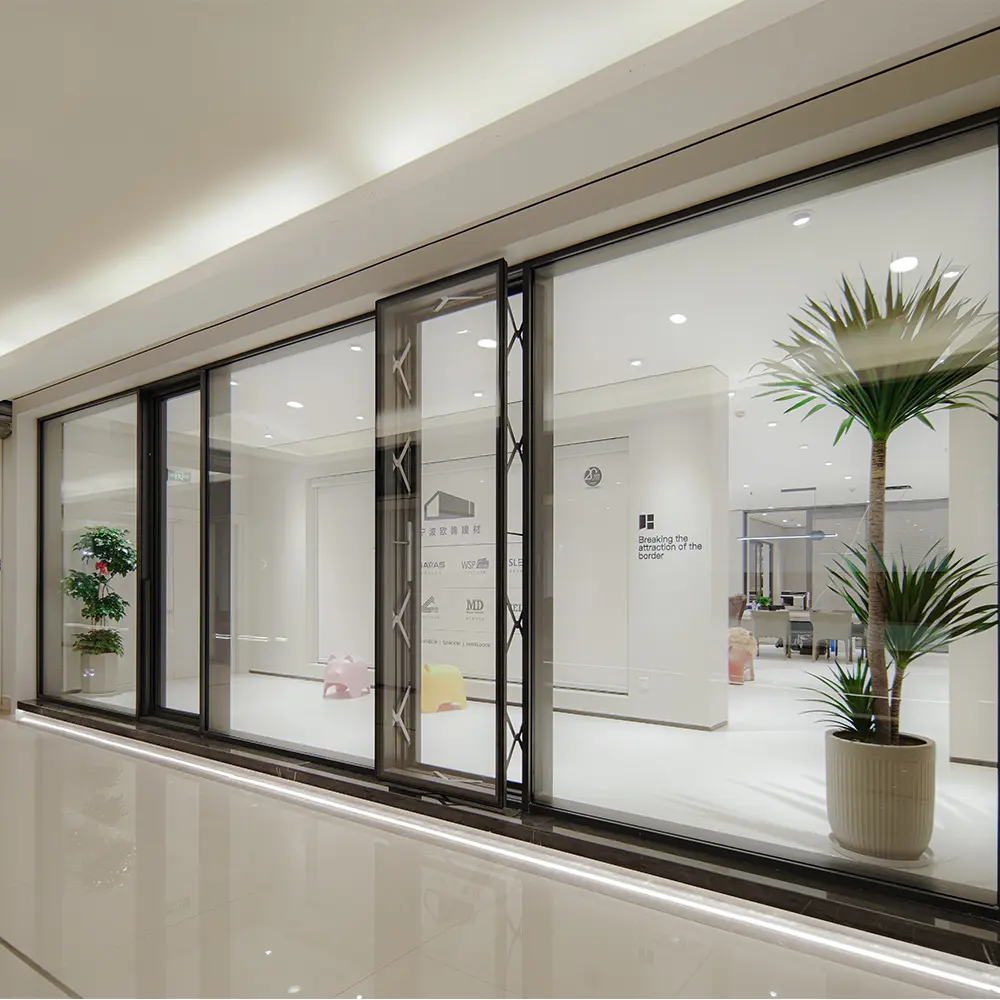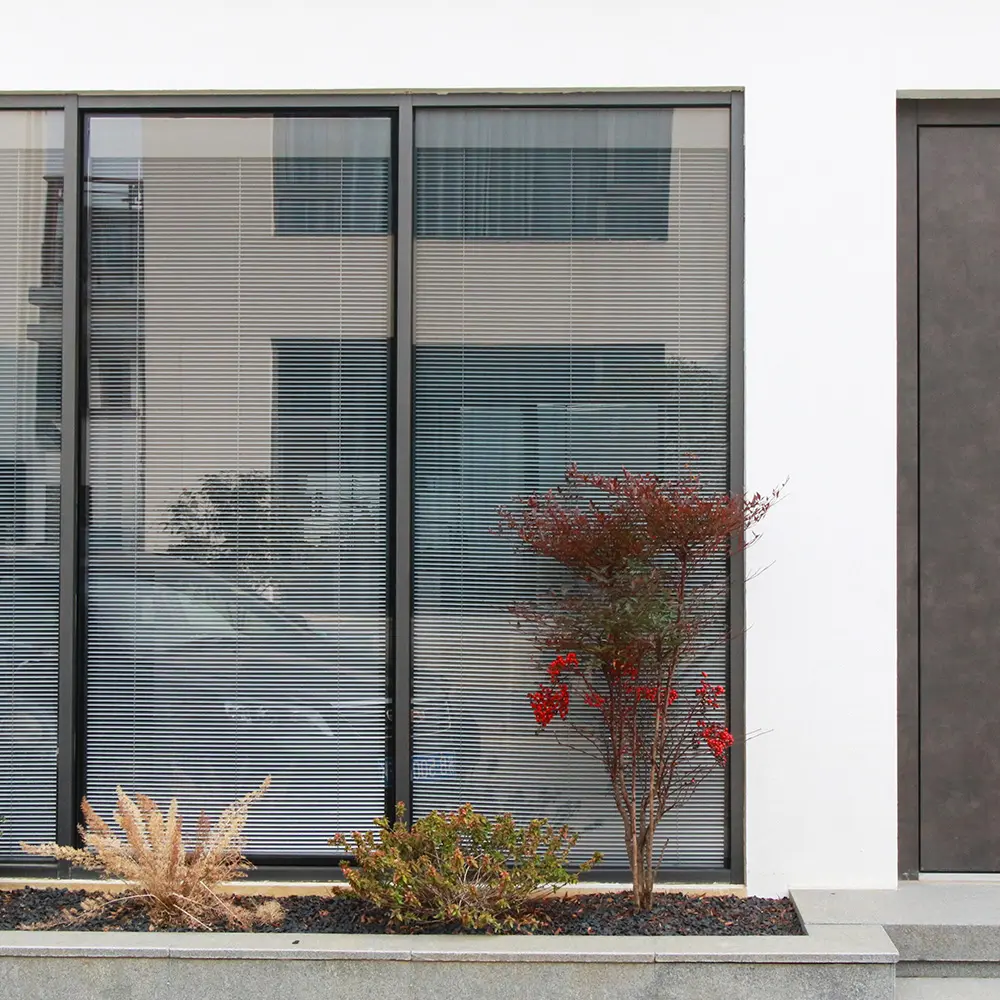Inovacija i funkcionalnost u modernom arhitektonskom dizajnu
U današnjem brzo mijenjajućem se građevinskom sektoru, fasade zgrada igraju ključnu ulogu u oblikovanju ne samo estetike, već i energetske učinkovitosti i udobnosti boravka. Među tim sustavima fasada, zavjesne zidove ističu se kao odlikujuće značajke savremenih visokih zgrada, komercijalnih kompleksa i institucionalnih objekata. Više nego što su samo vanjska ljuska zgrade, fasadni zidovi povezuju oblik i funkcionalnost, podržavajući arhitektonski koncept istovremeno poboljšavajući učinak zgrade. Uz pojavu tehnologija poput pametnih prozorskih zaslona, funkcionalnost fasadnih zidova dostiže potpuno novi nivo.
Osnovni koncept fasadnih zidova
Definicija i strukturalna uloga
Zavjesne zidove su nestrukturalne vanjske obloge pričvršćene za okvir zgrade. Za razliku od tradicionalnih zidova, fasadni zidovi ne nose težinu zgrade, osim vlastite. Umjesto toga, njihova primarna uloga je da otpiraju prodiranju zraka i vode, podnose opterećenje vjetra i omogućavaju svjetlosti da prodre duboko u unutrašnje prostore. Ovi zidovi često uključuju veće površine stakla, aluminijske okvire i integrirane elemente za sjenčanje, poput pametnog prozorskog zaslona, koji nudi dodatnu kontrolu sunčeve svjetlosti i privatnost.
Razvoj u povijesti arhitekture
The sustav zavjesnog zida znatno se razvila od svog uvođenja u ranom 20. stoljeću. U početku ograničena na velike komercijalne objekte, fasadne stijene su postale uobičajena značajka u stambenim toranjima i objedinjenim razvojnim projektima. Kako su propisi o građevinskoj energetskoj učinkovitosti i održivosti postali stroži, inovacije poput pametnih prozorskih zaslona postale su ključne za održavanje usklađenosti i smanjenje utjecaja na okoliš.
Materijali i tehnologija iza fasadnih stijena
Staklo i aluminijumski komponenti
Većina sustava fasadnih stijena napravljena je od aluminijumskih okvira u koje su ugrađene staklene ploče. Ovi materijali su omiljeni zbog svojstava lagane težine, strukturne izdržljivosti i jednostavnosti održavanja. Ugradnja pametnih prozorskih zaslonâ u ove staklene ploče može dodatno poboljšati učinkovitost zgrade reguliranjem unutarnje temperature i smanjenjem zaslijepljujućeg svjetla bez gubitka prirodnog svjetla.
Izolacija i energetske performanse
Kako bi se riješili problemi toplinskog mosta i izolacije, savremeni zavjesni fasadni sustavi često uključuju dvostruko ili trostruko ostakljenje, prevlake s niskim emisijskim koeficijentom i prekide toplinskog toka. Pametni zasloni za prozore dopunjuju ove tehnologije dinamičkim prilagođavanjem razinama sunčeve svjetlosti, čime doprinose smanjenju troškova grijanja i hlađenja te poboljšanju općeg komfora u unutrašnjosti.
Unapređenje estetike i dnevne svjetlosti
Prozirnost i vizualni učinak
Zavjesne fasade nude neusporedivu prozirnost, čime zgradama daju elegantan i moderni izgled te potiču vizualnu povezanost između unutrašnjih i vanjskih prostora. Pametni zaslon za prozore održava ovaj estetski izgled nudeći besprijekoran solarne sjenila bez ometanja pogleda, što ih čini omiljenim izborom među dizajnerima i korisnicima.
Maksimaliziranje upotrebe dnevne svjetlosti
Pristup dnevnoj svjetlosti povezan je s povećanom produktivnošću i dobrobitima. Fasadne stijene omogućuju prodiranje velike količine dnevne svjetlosti, a kada se kombiniraju s pametnim zaslonima na prozorima, zgrade mogu učinkovitije kontrolirati odsjaje i izloženost UV zrakama. Ova kombinacija podržava standarde za zdrave zgrade (WELL Building Standards) i doprinosi zdravijoj unutarnjoj okolini.

Energetska učinkovitost i održivost
Smanjenje operativnih troškova
Zgrade koje uključuju fasadne stijene s pametnim zaslonima na prozorima često imaju smanjene troškove energije zbog poboljšane termalne regulacije i manje oslanjanja na vještačko osvjetljenje. Optimizacijom interakcije zgrade s prirodnim elementima, ove sustavi jasno pokazuju dugoročne ekonomske pogodnosti.
Podrška za certifikate zelenih zgrada
Ugradnja pametnih zaslonjenih prozora u sustave zavjesnih fasada podržava certifikacije poput LEED i BREEAM. Ovi elementi doprinose ostvarivanju bodova u kategorijama poput dnevne svjetlosti i pogleda, termalnog komfora i energetske učinkovitosti. Investitori i vlasnici zgrada sve više prihvaćaju takve tehnologije kako bi poboljšali svoje certifikate održivosti.
Integracija pametnih prozorskih zaslona u zavjesne fasade
Pristaljivo upravljanje svjetlom
Pametni prozorski zasloni mogu se integrirati u zavjesne fasade na način koji omogućuje automatske ili ručne prilagodbe na temelju intenziteta sunčeve svjetlosti, uzoraka korištenja prostora ili sustava automatizacije zgrade. Ovaj stupanj kontrole znatno doprinosi uštedi energije, istovremeno poboljšavajući korisničko iskustvo.
Prilagodba i fleksibilnost
Ove zasloni su vrlo prilagodljivi i bez problema se uklapaju u različite dizajne zavjesnih fasada. Bilo da se radi o sjedištu korporacije, obrazovnoj ustanovi ili kompleksu luksuznih apartmana, pametni zasloni za prozore mogu se prilagoditi kako bi zadovoljili specifične zahtjeve učinkovitosti i estetike, bez narušavanja arhitektonskog integriteta zavjesne fasade.
Sigurnost i strukturna otpornost
Opterećenje vjetrom i otpornost na udar
Zavjesne fasade moraju izdržati opterećenja poput vjetra i seizmičkih sila. Savremeni sustavi temeljito se testiraju kako bi zadovoljili međunarodne standarde sigurnosti. Pametni zasloni za prozore ne utječu na strukturnu izdržljivost zavjesnih fasada, što ih čini sigurnim dodatkom koji poboljšava funkcionalnost bez povećanja rizika.
Razmatranje sigurnosti od požara
Negoriva materijala standardna su u izgradnji zavjesnih fasada, uključujući aluminijske okvire i termički ili laminirano staklo. Pametni zasloni za prozore napravljeni od materijala otpornih na vatru usklađeni su s ovim sigurnosnim protokolima, čime se osigurava da inovacije ne naruše sigurnost zgrade.
Aspekti ugradnje i održavanja
Pojašnjena procesa instalacije
Prefabricirane ploče zavjesne fasade omogućuju bržu montažu na gradilištu, smanjujući troškove rada i vremenske okvire izgradnje. Pametne zaslone za prozore moguće je integrirati tijekom faze prefabricacije ili dodati naknadno nakon ugradnje, čime se osigurava fleksibilnost za developerima i izvođačima radova.
Prednosti dugoročne održavanja
Moderne zavjesne fasade dizajnirane su za izdržljivost i jednostavnost održavanja. Dodavanje pametnog zaslona za prozor ne otežava održavanje; zapravo, neki modeli nude mogućnost samopraćenja ili zahtijevaju minimalnu intervenciju. To pomaže upraviteljima zgrada da održavaju visoke performanse bez prevelikih troškova rada ili sredstava.
Univerzalnost za različite vrste zgrada
Komercijalne i institucionalne zgrade
Fasadne zidovi su standard u komercijalnim uredima i institucionalnim zgradama poput sveučilišta i bolnica. Pametni zasloni na prozorima poboljšavaju funkcionalnost poboljšanjem udobnosti unutrašnjosti, smanjenjem refleksije na elektroničkim uređajima i optimizacijom osvjetljenja za rad i učenje.
Stambene i kombinirane zgrade
U stambenim neboderima i kombiniranim razvojnim projektima, fasadni zidovi nude panoramski pogled i osjećaj otvorenosti. Pametni zasloni na prozorima pružaju nužnu zaštitu od sunca i privatnost, udovoljavajući potrebama stanovnika, a istovremeno dopunjujući ukupni dizajn zgrade.
Buduća trendovi u sustavima fasadnih zidova
Integracija s pametnim sustavima za zgrade
Pametni zasloni na prozorima sve više postaju dio integriranih sustava upravljanja zgradama (BMS). To omogućuje stvaranje trenutnih prilagodbi na temelju podataka o vremenu, potrošnji energije ili korištenju prostora, čime fasadni zidovi postaju aktivni sudionik u inteligenciji zgrade, a ne pasivni omotač.
Napredni materijali i automatizacija
Od elektrokromnog stakla do fotonaponskih ploča, budućnost zavjesnih fasada kreće se prema većoj samodostatnosti i interaktivnosti. Pametni zasloni na prozorima igraju ključnu ulogu u toj evoluciji, povezujući pasivni dizajn i aktivno upravljanje okolišem.
Zaključak: Zašto su zavjesne fasade važnije nego ikad
U potrazi za pametnijim, učinkovitijim i estetski ugodnijim zgradama, zavjesne fasade važnije su nego ikad. Njihova sposobnost integracije naprednih materijala i sustava, poput pametnog zaslona na prozoru, osigurava da zadovolje visoke zahtjeve savremene arhitekture. Dok gradovi postaju gušći i održivost sve važnija, zavjesne fasade opremljene pametnim tehnologijama i dalje će oblikovati nebo gradova i postavljati nove standarde učinkovitosti zgrada.
Česta pitanja
Što je sustav zavjesne fasade?
Fasadni sustav je ne-noseći vanjski pokrivač zgrade koji je obično napravljen od stakla i metala. On pomaže u zaštiti zgrade od vremenskih utjecaja istovremeno propuštajući dnevnu svjetlost u unutrašnjost.
Kako funkcionira pametni zaslon na prozoru u sustavima staklenih fasada?
Pametni zasloni na prozorima automatski ili ručno prilagođavaju količinu svjetla i topline koja ulazi kroz staklenu fasadu. Oni pomažu u poboljšanju energetske učinkovitosti, smanjenju bljeska i povećanju udobnosti korisnika.
Je li pametne zaslone prikladno ugraditi u postojeće sustave staklenih fasada?
Da, mnogi pametni zasloni mogu se ugraditi u postojeće sustave staklenih fasada. To ih čini svestranim rješenjem za poboljšanje učinkovitosti zgrade bez potrebe za većim strukturnim promjenama.
Utječu li pametni zasloni na prozorima na prozirnost staklenih fasada?
Ne, pametni zasloni na prozorima dizajnirani su tako da zadrže vizualnu jasnoću dok nude zaštitu od sunca i sjenjenje. Oni poboljšavaju, a ne ometaju estetske kvalitete staklenih fasada.
Sadržaj
- Inovacija i funkcionalnost u modernom arhitektonskom dizajnu
- Osnovni koncept fasadnih zidova
- Materijali i tehnologija iza fasadnih stijena
- Unapređenje estetike i dnevne svjetlosti
- Energetska učinkovitost i održivost
- Integracija pametnih prozorskih zaslona u zavjesne fasade
- Sigurnost i strukturna otpornost
- Aspekti ugradnje i održavanja
- Univerzalnost za različite vrste zgrada
- Buduća trendovi u sustavima fasadnih zidova
- Zaključak: Zašto su zavjesne fasade važnije nego ikad
- Česta pitanja

